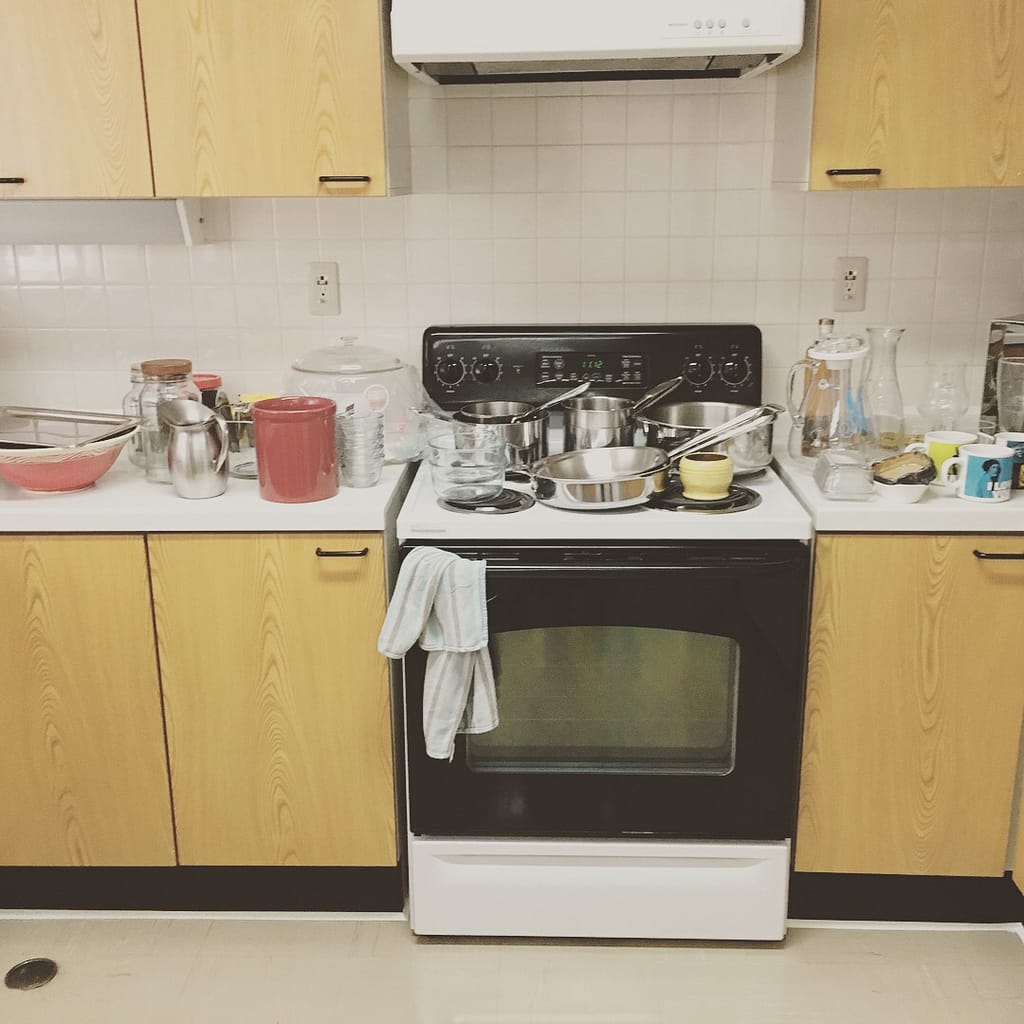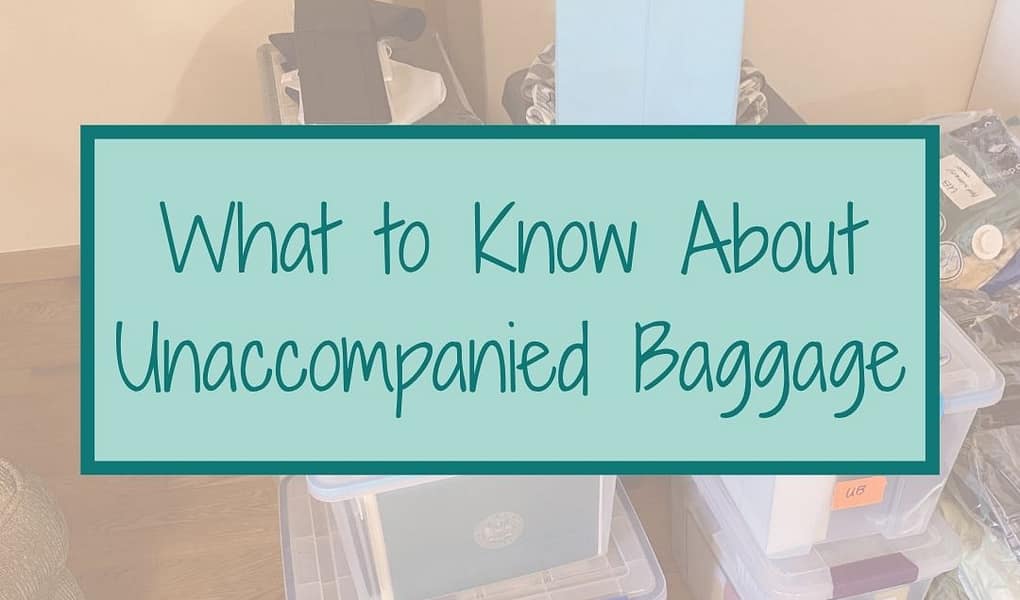I married my husband when he was stationed in North Carolina. It wasn’t that far from where I was living, so it was easy enough to move down. Previously, I moved myself, with the help of family, into and out of college, then into my first apartment (and all subsequent apartments). A few carloads back and forth and one trip with my dad’s flatbed trailer were all it took. I didn’t have a ton of stuff to move anyway.
My first move with the military was uncharted territory. Not only was it my first time moving away from the East Coast, but it was also my first time using a moving company. To further complicate everything, we were moving overseas.
I didn’t know Unaccompanied Baggage was an option. I was ready, but unenthused, about moving our family across the ocean with just one big household goods shipment and our bags for the airplane. To me, it was a logistical nightmare.
Thankfully, that wasn’t how it had to be.
What is Unaccompanied Baggage?
Typically, military moves within the US have two options. Either the military handles everything, and hires the moving company that moves you. Or, you can choose to move yourself. Sometimes that looks like packing your own U-Haul, but it could also mean finding and vetting your own moving company. Of course, you want to work within the money the military gives you to move if you don’t want to pay out of pocket for expenses.
However, if you’re moving OCONUS, you don’t have the option of moving yourself. While there are usually extra baggage allowances for the airplane, most of your stuff is at the mercy of the military movers. And shipping household goods overseas is a long process.
For an OCONUS move, you’ll have two shipments to schedule. One is Household Goods, or HHG. With HHG, your items, packed and crated in wooden crates, travel to your duty station by boat. Most Household Goods shipments arrive at their destination 8-12 weeks after packing out.
The second shipment is Unaccompanied Baggage, or UB. The movers will also crate your items for this shipment, but it doesn’t take quite as long to arrive since it travels by air. Your UB shipment is often scheduled and packed first, and arrives at your duty station 6-8 weeks later.

The Do’s and Don’t’s of UB
Generally, UB shipments are limited to 2,000 pounds. However, depending on where you’re heading, you may have a lower weight allowance. If you’re going to an OCONUS location, this link may help determine your UB weight allowance based on your location. You can also check out the military regulations for HHG and Unaccompanied Baggage here (start with section 0514 HHG Weight).
Think of UB items as things you’d like to have early to make your life easier, but maybe can’t bring on the plane. Kitchen items, kid toys, and lamps are good examples of things typically packed in Unaccompanied Baggage.
Big furniture is not allowed in UB. Things like mattresses, dresses, couches, and entertainment centers will go in an HHG shipment. TVs are allowed, but they must be smaller than 32″. For two of our three UB shipments, we packed a 6-foot folding table and some camping chairs. If you have an infant or toddler still in a crib, you may be able to pack the crib in UB. One of the deciding factors is whether it lies flat when disassembled.
Thinking Through Your Timeline
Before packing your UB items, it’s helpful to know about how long you’ll be in temporary lodging after you arrive. When we moved to Japan, we only spent about a week in the hotel. This was much shorter than we anticipated, so we didn’t have much in our house for 6-7 weeks before our unaccompanied baggage arrived. In Italy, we stayed in lodging for almost 3 months before finding a home. This time, our baggage arrived before we were ready for it.
Some people choose to schedule the packing of their unaccompanied baggage shipment well before their Household Goods shipment. This has never been the case for us, as our orders usually come right at the last minute. But if there are things you can live without at your current duty station, it may be worth considering scheduling your unaccompanied baggage earlier.
It’s also totally fine to schedule the two shipments closer together. Leaving Japan, we had both our UB and HHG shipments packed on the same day. Leaving the US and Italy, UB was scheduled 2-3 days prior to HHG.
If possible, I avoid scheduling both shipments on the same day. As much as I can, I put everything for the UB shipment in one spot. I also like to use a different color duct tape to label any boxes or totes that I’ve pre-packed; HHG gets one color and UB gets another.
Know What’s Available Before You Pack
Knowing if your gaining installation will have loaner furniture is helpful. In both our overseas duty stations, we had access to a bed, a lamp or two, a dining table and chairs, wardrobes, a couch, and a coffee table. It’s all very basic (and not very comfortable), but it helps cover the gap until your things arrive. Many overseas stations allow you to keep your loaner furniture for the duration of your tour.
A side note: While many duty stations overseas have loaner furniture, that’s not always the case if you’re moving from overseas to the States.

For our most recent move, our gaining unit in the States didn’t have loaner furniture. This means we had to be more thoughtful in how we packed, knowing we wouldn’t have immediate access to a bed, a couch, and other creature comforts. In this case, we needed to bring our air mattress with us in our airplane baggage instead of putting it in UB.
Ideas for Items to Pack in Unaccompanied Baggage
A few months before we move, I like to pay attention to the things we reach for most often. I make a list and do my best to sort those items into an unaccompanied baggage shipment or things we pack and take on the airplane. It’s really never too early to start thinking about your move and noticing the items you use the most.
Every PCS is different. What works for this move might not work for your next move. It’s worth taking inventory of the items you use most often and determining if they should be packed in UB.
Here are some ideas on what to put in your unaccompanied baggage.
- Basic kitchen items
- Sheets for all the beds
- Towels for all the bodies
- Pet supplies
- Additional clothing to last until HHG arrives
- Stroller or wagon for kids
- Tools/toolbox to assemble any furniture you might buy while you wait
- Pro gear you might need sooner rather than later (this doesn’t count toward your weight allowance).
Sometimes you’ll want to consider an item’s dollar value against its weight and use. What I mean by that is – thinking about items you use often now and will want at your new duty station. An example for us was our infant bathtub. Our son was small and we used it every bath. If we packed it in UB, it wouldn’t arrive for 6-8 weeks. I knew I wanted one before then. But it was too big to pack in our airplane baggage. So we used it in the hotel at our losing unit, sold it (or donated it, I can’t remember), and bought a new one a few days after landing. It was worth the $20-$30 we had to spend to get a new one rather than packing the one we had.
You Got This!
Moving is well known to be one of the most stressful events in life. Add on the military red tape, and it can be downright debilitating. But remember – this will get done. All of your things will be packed, loaded, and moved. You and your family will get on a plane and arrive at a new place. No matter how overwhelming it feels, it all comes together. You’re doing great! You can do this!

Looking for More Help During Your PCS?
Check out my free eBook Moving with the Military: Unaccompanied Baggage. In it, I offer a more comprehensive packing list to help you think through what to pack for your move. You can also find all our PCS-related posts in one spot by clicking the Moving + PCS Season graphic.



